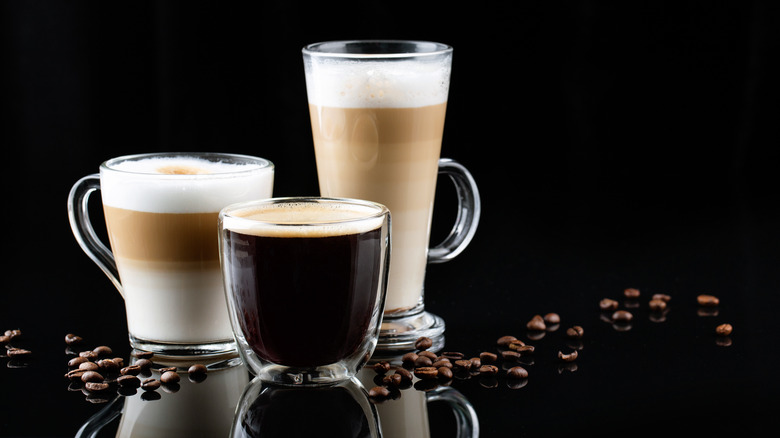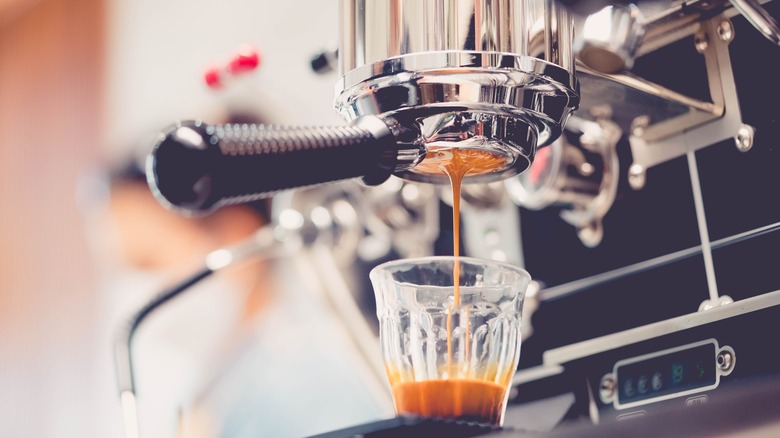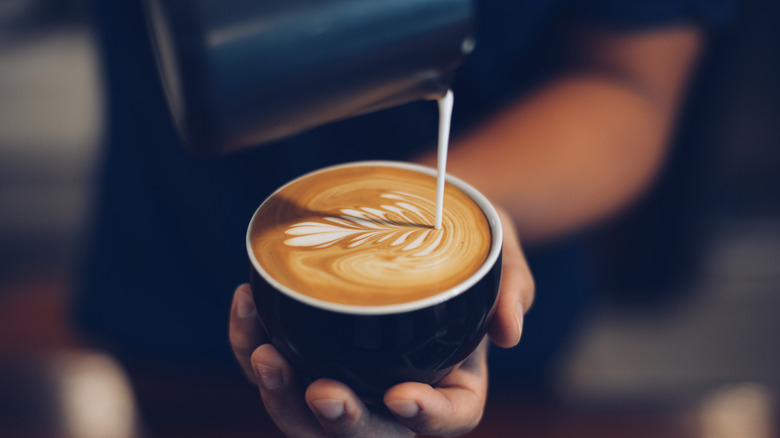What's The Difference Between Cappuccinos And Lattes?
If you're like 63% of Americans, you probably start your day off with a cup of coffee. According to Joe's Garage Coffee, over half of Americans drink this energy-boosting beverage at least once a day, which adds up to a whopping 400 million cups of coffee drunk in America every 24 hours. And while about 20% of people prefer their cup of Joe strong, dark, and black, according to YouGov America, there is certainly no shortage of ways to enjoy this popular beverage. Milk, cream, and sugar are the most common ways people dress up coffee's natural, bitter flavor. But coffee drinks can get a lot more creative — and if you need proof, just head on down to your local coffee shop.
On just about every coffee shop menu, you are sure to see plenty of fancy caffeinated beverages, from cold brew and iced coffee to lattes and cappuccinos. And while fewer people drink these types of coffee drinks every single day, they are far from unpopular. In fact, about 29% of Americans say they "love" cappuccinos. Lattes aren't far behind, with 27% of the adult population reporting they love the foamy drink, per YouGov America. But what exactly sets these steamed, milky beverages apart from a regular cup of Joe with milk in it? And what is the difference between a cappuccino and a latte, anyway?
Lattes and cappuccinos are made with espresso
Cappuccinos and lattes are both distinct from a standard cup of coffee because their base is made with espresso, rather than coffee. Coffee is made from the cherries of a coffee tree, which are harvested, dried, processed, and then roasted at temperatures of around 550 degrees Fahrenheit to give us the fragrant brown coffee beans we all know and love, according to the National Coffee Association. These whole beans can then be ground and brewed to make a nice hot cup of Joe.
Espresso is simply a different type of coffee, which is processed entirely the same way right up until the brewing process. Rather than pouring water over the grounds, espresso is made by forcing water through finely-ground coffee beans using very high water pressure, according to Serious Eats. This gives the resulting beverage a stronger, more concentrated flavor, a smooth, silky texture, and a pleasing foamy finish. Because espresso is far more concentrated than a standard cup of drip coffee, it contains more caffeine ounce per ounce, delivering about 63 mg in just one single serving, according to Consumer Reports. Both lattes and cappuccinos are made using milk and a standard one-ounce serving of espresso, But while they may have the same base ingredients, cappuccinos and lattes are not the same thing.
Lattes and cappuccinos deffer in their preparation
Both cappuccinos and lattes are made with a shot of espresso, topped with steamed milk and foam. But it is the proportions, rather than the ingredients, that sets these two drinks apart. Cappuccinos are made with distinct layers of espresso, steamed milk, and foam, with higher quantities of milk foam than steamed milk, which gives the drink a light, airy texture, according to Starbucks. Lattes, on the other hand, are made with more blended layers of steamed milk and espresso, finished off by a thin layer of foam coating the top, making for a smoother, richer, creamier drink.
Many people enjoy the light, smooth, and slightly sweet flavor of this combination of espresso, milk, and foam. But while there are many reasons to enjoy a milky espresso beverage like a latte or cappuccino, the extra caffeine boost is not one of them. Although espresso has more caffeine than drip coffee ounce for ounce, an average 8-ounce cup of coffee generally has more caffeine than a standard cappuccino or latte because they are heavily diluted with milk. These drinks contain somewhere between 170 and 220 mg of caffeine per serving, according to Your Dream Coffee. Therefore, if you simply need an extra jolt of energy in the morning, a cup of regular old Joe might still be your best bet.


